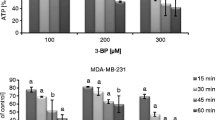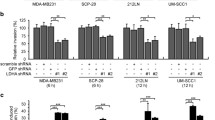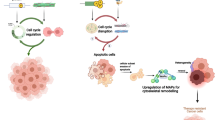Abstract
The small molecule 3-bromopyruvate (3BP), is an anticancer molecule that acts by hindering glycolysis and mitochondrial function leading to energy depletion and consequently, to cell death. In this work we have focused on understanding how the glycolytic inhibition affects cancer cell structural features. We showed that 3BP leads to a drastic decrease in the levels of β-actin and α-tubulin followed by disorganization and shrinkage of the cytoskeleton in breast cancer cells. 3BP inhibits cell migration and colony formation independently of the activity of metalloproteinases. To disclose if these structural alterations occurred prior to 3BP toxic effect, non-toxic concentrations of 3BP were used and we could observe that 3BP was able to inhibit energy production and induce loss of β-actin and α-tubulin proteins. This was accompanied with alterations in cytoskeleton organization and an increase in E-cadherin levels which may indicate a decrease in cancer cells aggressiveness. In this study we demonstrate that 3BP glycolytic inhibition of breast cancer cells is accompanied by cytoskeleton disruption and consequently loss of migration ability, suggesting that 3BP can potentially be explored for metastatic breast cancer therapy.








Similar content being viewed by others
Data availability
The datasets generated during and/or analyzed during the current study are available from the corresponding author on reasonable request.
Code availability
Not applicable.
References
Ko YH, Pedersen PL, Geschwind JF. Glucose catabolism in the rabbit VX2 tumor model for liver cancer: characterization and targeting hexokinase. Cancer Lett. 2001;173(1):83–91.
Ko YH, Smith BL, Wang Y, Pomper MG, Rini DA, Torbenson MS, Hullihen J, Pedersen PL. Advanced cancers: eradication in all cases using 3-bromopyruvate therapy to deplete ATP. Biochem Biophys Res Commun. 2004;324(1):269–75. https://doi.org/10.1016/j.bbrc.2004.09.047.
Mathupala SP, Ko YH, Pedersen PL. Hexokinase II: cancer’s double-edged sword acting as both facilitator and gatekeeper of malignancy when bound to mitochondria. Oncogene. 2006;25(34):4777–86. https://doi.org/10.1038/sj.onc.1209603.
Ganapathy-Kanniappan S, Geschwind JF, Kunjithapatham R, Buijs M, Vossen JA, Tchernyshyov I, Cole RN, Syed LH, Rao PP, Ota S, Vali M. Glyceraldehyde-3-phosphate dehydrogenase (GAPDH) is pyruvylated during 3-bromopyruvate mediated cancer cell death. Anticancer Res. 2009;29(12):4909–18.
Ganapathy-Kanniappan S, Geschwind JF. Tumor glycolysis as a target for cancer therapy: progress and prospects. Mol Cancer. 2013;12:152. https://doi.org/10.1186/1476-4598-12-152.
Baltazar F, Pinheiro C, Morais-Santos F, Azevedo-Silva J, Queiros O, Preto A, Casal M. Monocarboxylate transporters as targets and mediators in cancer therapy response. Histol Histopathol. 2014;29(12):1511–24. https://doi.org/10.14670/HH-29.1511.
Azevedo-Silva J, Queiros O, Ribeiro A, Baltazar F, Young KH, Pedersen PL, Preto A, Casal M. The cytotoxicity of 3-bromopyruvate in breast cancer cells depends on extracellular pH. Biochem J. 2015;467(2):247–58. https://doi.org/10.1042/BJ20140921.
Queiros O, Preto A, Pacheco A, Pinheiro C, Azevedo-Silva J, Moreira R, Pedro M, Ko YH, Pedersen PL, Baltazar F, Casal M. Butyrate activates the monocarboxylate transporter MCT4 expression in breast cancer cells and enhances the antitumor activity of 3-bromopyruvate. J Bioenerg Biomembr. 2012;44(1):141–53. https://doi.org/10.1007/s10863-012-9418-3.
Birsoy K, Wang T, Possemato R, Yilmaz OH, Koch CE, Chen WW, Hutchins AW, Gultekin Y, Peterson TR, Carette JE, Brummelkamp TR, Clish CB, Sabatini DM. MCT1-mediated transport of a toxic molecule is an effective strategy for targeting glycolytic tumors. Nat Genet. 2013;45(1):104–8. https://doi.org/10.1038/ng.2471.
Warburg O. On the origin of cancer cells. Science. 1956;123(3191):309–14.
Nakashima RA, Paggi MG, Scott LJ, Pedersen PL. Purification and characterization of a bindable form of mitochondrial bound hexokinase from the highly glycolytic AS-30D rat hepatoma cell line. Can Res. 1988;48(4):913–9.
Te Boekhorst V, Friedl P. Plasticity of cancer cell invasion-mechanisms and implications for therapy. Adv Cancer Res. 2016;132:209–64. https://doi.org/10.1016/bs.acr.2016.07.005.
Shay G, Lynch CC, Fingleton B. Moving targets: emerging roles for MMPs in cancer progression and metastasis. Matrix Biol. 2015;44–46:200–6. https://doi.org/10.1016/j.matbio.2015.01.019.
Breier G, Grosser M, Rezaei M. Endothelial cadherins in cancer. Cell Tissue Res. 2014;355(3):523–7. https://doi.org/10.1007/s00441-014-1851-7.
Jiang WG, Sanders AJ, Katoh M, Ungefroren H, Gieseler F, Prince M, Thompson SK, Zollo M, Spano D, Dhawan P, Sliva D, Subbarayan PR, Sarkar M, Honoki K, Fujii H, Georgakilas AG, Amedei A, Niccolai E, Amin A, Ashraf SS, Ye L, Helferich WG, Yang X, Boosani CS, Guha G, Ciriolo MR, Aquilano K, Chen S, Azmi AS, Keith WN, Bilsland A, Bhakta D, Halicka D, Nowsheen S, Pantano F, Santini D. Tissue invasion and metastasis: molecular, biological and clinical perspectives. Semin Cancer Biol. 2015. https://doi.org/10.1016/j.semcancer.2015.03.008.
Pedersen PL. 3-Bromopyruvate (3BP) a fast acting, promising, powerful, specific, and effective “small molecule” anti-cancer agent taken from labside to bedside: introduction to a special issue. J Bioenerg Biomembr. 2012;44(1):1–6. https://doi.org/10.1007/s10863-012-9425-4.
Azevedo-Silva J, Queiros O, Baltazar F, Ulaszewski S, Goffeau A, Ko YH, Pedersen PL, Preto A, Casal M. The anticancer agent 3-bromopyruvate: a simple but powerful molecule taken from the lab to the bedside. J Bioenerg Biomembr. 2016;48(4):349–62. https://doi.org/10.1007/s10863-016-9670-z.
Ganapathy-Kanniappan S, Geschwind JF, Kunjithapatham R, Buijs M, Syed LH, Rao PP, Ota S, Kwak BK, Loffroy R, Vali M. 3-Bromopyruvate induces endoplasmic reticulum stress, overcomes autophagy and causes apoptosis in human HCC cell lines. Anticancer Res. 2010;30(3):923–35.
Liu XH, Zheng XF, Wang YL. Inhibitive effect of 3-bromopyruvic acid on human breast cancer MCF-7 cells involves cell cycle arrest and apoptotic induction. Chin Med J. 2009;122(14):1681–5.
Wang P, Li JC. Trichosanthin-induced specific changes of cytoskeleton configuration were associated with the decreased expression level of actin and tubulin genes in apoptotic Hela cells. Life Sci. 2007;81(14):1130–40. https://doi.org/10.1016/j.lfs.2007.08.016.
Ling X, Cheng Q, Black JD, Li F. Forced expression of survivin-2B abrogates mitotic cells and induces mitochondria-dependent apoptosis by blockade of tubulin polymerization and modulation of Bcl-2, Bax, and survivin. J Biol Chem. 2007;282(37):27204–14. https://doi.org/10.1074/jbc.M705161200.
Wilson L, Jordan MA. New microtubule/tubulin-targeted anticancer drugs and novel chemotherapeutic strategies. J Chemother. 2004;16(Suppl 4):83–5. https://doi.org/10.1179/joc.2004.16.Supplement-1.83.
Pichla M, Sroka J, Pienkowska N, Piwowarczyk K, Madeja Z, Bartosz G, Sadowska-Bartosz I. Metastatic prostate cancer cells are highly sensitive to 3-bromopyruvic acid. Life Sci. 2019;227:212–23. https://doi.org/10.1016/j.lfs.2019.03.066.
Aggarwal S, Singh M, Kumar A, Mukhopadhyay T. SRD5A2 gene expression inhibits cell migration and invasion in prostate cancer cell line via F-actin reorganization. Mol Cell Biochem. 2015;408(1–2):15–23. https://doi.org/10.1007/s11010-015-2478-z.
Buijs M, Wijlemans JW, Kwak BK, Ota S, Geschwind JF. Antiglycolytic therapy combined with an image-guided minimally invasive delivery strategy for the treatment of breast cancer. JVIR. 2013;24(5):737–43. https://doi.org/10.1016/j.jvir.2013.01.013.
Akahane T, Akahane M, Shah A, Connor CM, Thorgeirsson UP. TIMP-1 inhibits microvascular endothelial cell migration by MMP-dependent and MMP-independent mechanisms. Exp Cell Res. 2004;301(2):158–67. https://doi.org/10.1016/j.yexcr.2004.08.002.
Pereira da Silva AP, El-Bacha T, Kyaw N, dos Santos RS, da-Silva WS, Almeida FC, Da Poian AT, Galina A,. Inhibition of energy-producing pathways of HepG2 cells by 3-bromopyruvate. Biochem J. 2009;417(3):717–26. https://doi.org/10.1042/BJ20080805.
Tang Z, Yuan S, Hu Y, Zhang H, Wu W, Zeng Z, Yang J, Yun J, Xu R, Huang P. Over-expression of GAPDH in human colorectal carcinoma as a preferred target of 3-bromopyruvate propyl ester. J Bioenerg Biomembr. 2012;44(1):117–25. https://doi.org/10.1007/s10863-012-9420-9.
Damiani C, Colombo R, Gaglio D, Mastroianni F, Pescini D, Westerhoff HV, Mauri G, Vanoni M, Alberghina L. A metabolic core model elucidates how enhanced utilization of glucose and glutamine, with enhanced glutamine-dependent lactate production, promotes cancer cell growth: the WarburQ effect. PLoS Comput Biol. 2017;13(9): e1005758. https://doi.org/10.1371/journal.pcbi.1005758.
DeBerardinis RJ, Mancuso A, Daikhin E, Nissim I, Yudkoff M, Wehrli S, Thompson CB. Beyond aerobic glycolysis: transformed cells can engage in glutamine metabolism that exceeds the requirement for protein and nucleotide synthesis. Proc Natl Acad Sci USA. 2007;104(49):19345–50. https://doi.org/10.1073/pnas.0709747104.
Stoddard PR, Williams TA, Garner E, Baum B. Evolution of polymer formation within the actin superfamily. Mol Biol Cell. 2017;28(19):2461–9. https://doi.org/10.1091/mbc.E15-11-0778.
Li L, Chen Q, Yu Y, Chen H, Lu M, Huang Y, Li P, Chang H. RKI-1447 suppresses colorectal carcinoma cell growth via disrupting cellular bioenergetics and mitochondrial dynamics. J Cell Physiol. 2020;235(1):254–66. https://doi.org/10.1002/jcp.28965.
Kang Y, Massague J. Epithelial-mesenchymal transitions: twist in development and metastasis. Cell. 2004;118(3):277–9. https://doi.org/10.1016/j.cell.2004.07.011.
Hajra KM, Ji X, Fearon ER. Extinction of E-cadherin expression in breast cancer via a dominant repression pathway acting on proximal promoter elements. Oncogene. 1999;18(51):7274–9. https://doi.org/10.1038/sj.onc.1203336.
Shankar J, Messenberg A, Chan J, Underhill TM, Foster LJ, Nabi IR. Pseudopodial actin dynamics control epithelial-mesenchymal transition in metastatic cancer cells. Can Res. 2010;70(9):3780–90. https://doi.org/10.1158/0008-5472.CAN-09-4439.
Sheng W, Wang G, La Pierre DP, Wen J, Deng Z, Wong CK, Lee DY, Yang BB. Versican mediates mesenchymal-epithelial transition. Mol Biol Cell. 2006;17(4):2009–20. https://doi.org/10.1091/mbc.e05-10-0951.
Acknowledgements
This work is dedicated to the memory of Professor André Goffeau, a visionary scientist who encouraged us to study 3-bromopyruvate for cancer research. This work was supported by the strategic programme UID/BIA/04050/2019 funded by Portuguese funds through the FCT I.P., João Azevedo-Silva received a fellowship from the Portuguese government from the FCT through FSE (Fundo Social Europeu) and POPH (Programa Operacional Potencial Humano) [grant number SFRH/BD/76038/2011]. We are grateful to Joana Paredes (I3S, Portugal) for the gently donation of E-cadherin antibody used in this work.
Funding
This work was supported by the strategic programme UID/BIA/04050/2019 funded by Portuguese funds through the FCT I.P., João Azevedo-Silva received a fellowship from the Portuguese government from the FCT through FSE (Fundo Social Europeu) and POPH (Programa Operacional Potencial Humano) [Grant Number SFRH/BD/76038/2011].
Author information
Authors and Affiliations
Contributions
JAS carried out the Western-blots, fluorescence microscopy, colony formation assay, wound-healing assay and metalloproteinase activity. DV, OQ and FB carried out the metabolic analysis. AA carried out western-blots and confocal microscopy. YK and PL had verified the results and participated in the critical and conceptual analysis of the study. JAS, AP and MC conceived the study and participated in its design and implementation. JAS wrote the manuscript supervised by AP and MC. All authors read and approved the final manuscript.
Corresponding authors
Ethics declarations
Conflict of interest
The authors declare no conflicts of interest.
Ethical statement
The authors declare that all the ethical standards have been fulfilled.
Additional information
Publisher's Note
Springer Nature remains neutral with regard to jurisdictional claims in published maps and institutional affiliations.
Rights and permissions
About this article
Cite this article
Azevedo-Silva, J., Tavares-Valente, D., Almeida, A. et al. Cytoskeleton disruption by the metabolic inhibitor 3-bromopyruvate: implications in cancer therapy. Med Oncol 39, 121 (2022). https://doi.org/10.1007/s12032-022-01712-0
Received:
Accepted:
Published:
DOI: https://doi.org/10.1007/s12032-022-01712-0




